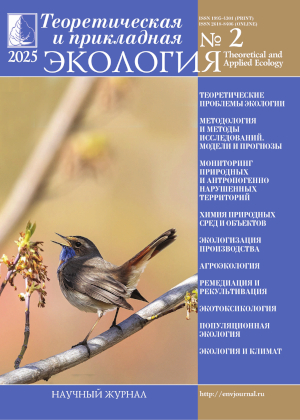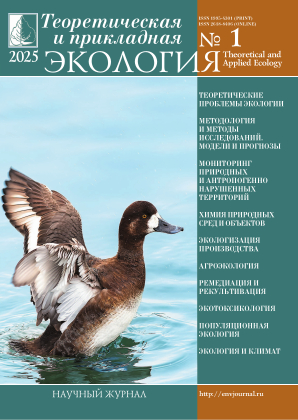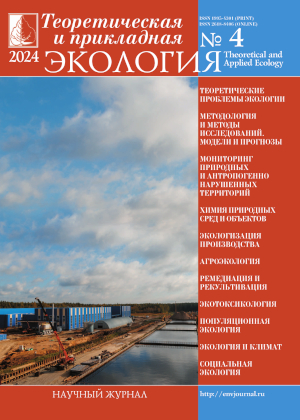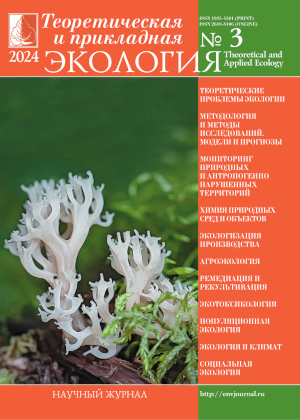 ISSN 1995-4301
ISSN 1995-4301(Print)
ISSN 2618-8406
(Online)
Online version of the journal
|
Influence of various types of surfactants on gas emissions and microbiota of the liquid fraction of manure effluents |
||||
| L.V. Pilip, N.V. Syrchina, E.P. Kolevatykh, V.V. Rutman | ||||
| Section: Monitoring of natural and anthropogenically disturbed areas |
||||
| Various surfactants are widely used in modern industrial animal husbandry. As part of detergents and pharmacological veterinary preparations, surfactants inevitably fall into manure effluents (ME), resulting in a change in the properties of ME. The study of the effect of various types of surfactants on the gas release and microbiota of the liquid fraction (LF) of ME was carried out on the example of surfactants with different biocidal activity: sodium laureth sulfate – anionactive surfactant (AS), lauryldimethylamine oxide – nonionic surfactant (NS) and benzalkonium chloride – cationic surfactant (CS). The studies were conducted under laboratory conditions. The total observation time since the introduction of additives in the LF (0,01 g per 1 liter) was 14 days. The obtained data shows changes in the dynamics of greenhouse gases (CH4 and CO2) and odor-forming substances (H2S, NH3, RSH) emission, as well as in the composition of the microbiota of biofilms and bacterioplankton, under the influence of surfactants. The dynamics of the CH4 emission differ from those of other gases. The use of CS leads to a gradual increase in CH4 emission a week after application. This may be due to increased permeability of the cytoplasmic membranes of methanogenic archaea with increased chemical resistance. The application of various types of surfactants into the LF has different effects on the dynamics of the odor-forming substances emission, and the active emission period of mercaptans becomes longer. The highest level of ethyl mercaptan was observed in the option with NS. There was no significant difference in the effect of low concentrations of various surfactants on the microbiota of LF, however the AS has a more pronounced bacteriostatic effect on set of indicators. The most tolerant to the effects of all types of surfactants were Clostridia, which dominates the microbiota biofilms and bacterioplankton. Fungi were the second most abundant in biofilms of the LF. | ||||
| Keywords: manure effluents, surfactants, microbiota, biofilms, bacterioplankton, greenhouse gas emission, odor |
||||
 |
||||
| Article published in number 3 for 2023 DOI: 10.25750/1995-4301-2023-3-059-072 |
||||
|
||||
Gelatin films containing plant extracts |
||||
| E.S. Shirokova, E.V. Tovstik, A.I. Fokina | ||||
| Section: Ecologization of industry |
||||
| Polymer films based on traditional synthetic polymers are widely used throughout the world. However, the impossibility of biodegradation of synthetic polymers in the environment and, as a result, the accumulation of polymeric waste stimulates using biodegradable bio-based polymers instead of traditional ones. One of them is gelatin. Gelatin is biodegradable, it has good mechanical and barrier properties, high film forming ability and widely distributed.
Presented research includes results of a investigation of gelatin films based on aqueous extracts from the leaves of sea buckthorn leaves, plantain leaves, pine needles (film based on distilled water used as a control). The qualitative and quantitative composition of polyphenolic compounds (the sum of polyphenols, flavonoids and tannins) that make up the extracts was determined using physico-chemical methods of analysis. The antioxidant activity of plant extracts has been established. The highest amount of antioxidants (64 mg/100 сm 3 ) was found in extracts from sea buckthorn leaves. Using plant extracts in the composition of gelatin films did not cause significant changes in their thermal stability; it was confirmed by thermogravimetric analysis. Significant changes in properties compared to the control were noted for samples containing sea buckthorn leaf extract. Thus, the value of the stress at break was 11.6 MPa, and the elongation at break was 100% (11.4 MPa and 65% for control, respectively). For all the studied samples, there was a lower water absorption (200–223% after 60 minutes) compared to the control (254% after 60 minutes) and vapor permeability values comparable to the control. Such combination of film properties, with a high content of antioxidants in plant extracts, allows us to consider these materials as promising for the creation of biodegradable packaging films with antibacterial activity. |
||||
| Keywords: Plantago major L., Hippоphaе rhamnoides L., Pinus sylvestris L., polyphenols, biodegradable polymers |
||||
.jpg) .jpg) |
||||
| Article published in number 3 for 2023 DOI: 10.25750/1995-4301-2023-3-129-139 |
||||
|
||||
The factors of forming the floristic structure of railway stations embankment (on the example of the Republic of Bashkortostan) |
||||
| S.A. Gareeva, A.F. Khusainov, L.M. Abramova | ||||
| Section: Monitoring of natural and anthropogenically disturbed areas |
||||
| Railroad embankments are special types of ruderal ecotopes in human-transformed areas. Railways are active channels for transzonal plant migration and are open to colonization by alien plant species. The aim of the research was to identify the factors of formation as well as the comparative analysis of the activity of partial floras species at six railway stations of the Republic of Bashkortostan located in three natural and climatic zones of the Southern Urals: the forest-steppe Cis-Urals, the steppe Trans-Urals and the Mountain-Forest Urals. The total flora comprised 288 species of vascular plants, including: 125 at the Kandry station, 124 at Buzdyak, 105 at Beloretsk, 128 at Inzer station, 157 at Sibai, 115 at Almukhametovo. A four-point scale of species activity was used for the comparative analysis of the flora of railway stations. It is shown that 21 species are found in all zones with the same degree of activity (“often” and “very often”). 125 species of vascular plants occur exclusively on the railway embankments of one of the studied stations. The flora of railway stations have similarities from 0.50 to 0.71 on the Sørensen-Czekanowski coefficient, which is provided by a common core of anthropotolerant species with a wide ecological amplitude. The differences reflect the zonal nature of vegetation and are formed through the participation of native flora species adapted to the specific substrates of railway embankment. Also the contribution of accidental drift of plant seeds is significant. The contribution of the zonal factor in various natural and climatic zones differs: the less difference between the railway ecotopes and the landscape and vegetation conditions of adjacent natural areas of the respective natural zone, the higher the participation of apophytic species in the forming of partial flora, and vice versa. | ||||
| Keywords: Southern Urals, railway embankments, plant migration, flora, species activity, Sørensen-Chekanowski coefficient, zonal factor |
||||
  |
||||
| Article published in number 3 for 2023 DOI: 10.25750/1995-4301-2023-3-081-087 |
||||
|
||||
Long-distance movements of small mammals during the autumn-winter period |
||||
| E.B. Grigorkina, G.V. Olenev | ||||
| Section: Population ecology |
||||
| First time in the East Urals radioactive trace zone (EURT) (Chelyabinsk region, Southern Urals) small mammals from natural population with rhodamine B (RB) label, received in last year were revealed. The aim of this study was to estimate long-distance movements (LDM) of small mammals during the autumn–winter season by method of group marking with bait containing RB. One-time ingestion of bait with RB ensures systemic marking, which fixed in keratin-containing structures (hairs, claws, vibrissae). Retention time of RB-label for wood mouse (Sylvaemus uralensis Pallas, 1811) was 338 days, for common shrew (Sorex araneus Linnaeus, 1758) – 312 days, for red-backed vole (Myodes rutilus Pallas, 1779) – 251 days. It has allowed for the first time to estimate LDM of wintering individuals during autumn–winter season from EURT zone to adjacent territories and vice versa. It was found that S. uralensis are able to settle within 10800 m, M. rutilus – 9500 m, S. araneus – 9300 m. These data are the maximum recorded distance for these species. There is a predominance of females both among wintering settled animals and distant migrants. Probably LDM of females is evolutionary more favorable to population as they serve as the potential reserve of a genetic variety. LDM provides spatial and functional connectivity of mouse-sized mammal’s populations and possibility of genetic information exchange between population groupings on both the impact and background territories. The technique of group marking with bait containing RB has shown the efficiency at research of spatial structure of small mammals during the autumn-winter period. It is advisable to include it in monitoring system in areas of local technogenic pollution as well as to use it to calibrate samples of animals in the study of remote effects of radiating and other toxic effects. | ||||
| Keywords: East Urals radioactive trace zone, group marking, small mammals, dispersal, autumn-winter period |
||||
| Article published in number 3 for 2023 DOI: 10.25750/1995-4301-2023-3-186-196 |
||||
|
||||
Altitudinal variation in ecological strategies across plant communities of different vegetation types |
||||
| A.B. Novakovskiy, Yu.A. Dubrovskiy, E.E. Kulygina, S.V. Degteva | ||||
| Section: Population ecology |
||||
| Grime’s CSR (competition-stress-ruderality) theory has found widespread use in modern ecology for the analysis of vegetation worldwide. This study aimed to verify if vegetation behavior predicted by this theory coincided with field observations along a highly pronounced altitudinal gradient and to determine if this behavior is the same for different vegetation types. We studied the 275 plots of different vegetation types in the Northern and Subpolar Urals (Russia). Based on the community-weighted mean approach, we allocated the CSR status of each plot. Then, we used generalized additive models and linear modeling to find relationships between CSR statuses, vegetation types and altitude. The plant communities were characterized by a predominance of species with competitor (C) and stress-tolerant (S) strategies and a small share of ruderal (R) species. According to the decrease in the share of competitors and the increase of stress-tolerators, the vegetation types were ranked as follows: forest (С: 47, S: 44), meadow (С: 47, S: 37), bush (С: 44, S: 46), mire (С: 42, S: 49) and mountain tundra (С: 35, S: 58). The different vegetation types showed different responses to elevation changes in the CSR terms. Meadows, bushes and mountain tundra showed the most corresponding behavior with Grime’s CSR theory predictions: a significant decrease of the C scores and an increase of S component (4–5% for every 100 m increase in elevation). Finally, forests and mires did not show notable changes in the CSR status. | ||||
| Keywords: Grime’s CSR, functional traits, altitude gradient, mountain vegetation |
||||
| Article published in number 3 for 2023 DOI: 10.25750/1995-4301-2023-3-160-170 |
||||
|
||||
Translocation of heavy metals into plants from the soil near the Alaverdi copper smelting enterprise |
||||
| A.R. Sukiasyan, T.A. Jhangiryan, S.A. Hunanyan, A.A. Kirakosyan | ||||
| Section: Chemistry of natural environments and objects |
||||
| The levels of heavy metals (HMs) in soil samples and plants grown on experimental plots near the Alaverdi copper smelting enterprise has been studied. The studies were conducted during the period of the enterprise’s operating in incomplete capacity (spring – summer 2022). The wind direction in the region was taken into account. The brown forest soils were taken from the topsoil horizon at a depth of 0–25 cm on the selected pilot plots located within 3; 10; 30 km from the enterprise. Potato, beet, carrot, pepper and eggplant were grown in field plots. The contents of HMs in soil and plant samples were determined by atomic absorption spectroscopy. A comparative series of Cu > Pb > Zn > Co > Mn was established according to the gross HMs content in soil samples from plots close to the enterprise (3 km). In this series of experiments the comparative series of mobile forms of HMs follows the same sequence but with lower values. The mobility of Cu, Pb, Zn and Co in soil samples was on average 15.5%, in the case of Mn – 25.5% (3 km). The highest mobility in soil samples from distant plots (30 km) in the wind-rose direction was detected for Cu, Co, and Mn (14.3% on average), and the mobility of Pb and Zn was 8%. Calculations of bio-ecological and geo-ecological coefficients showed that the studied plants are characterized by individual scenario of metabolic processes, but a common adaptation strategy to the stressor. It has been shown that HMs accumulate more in the reproductive organs of plants than in the vegetative ones. This explains the differences in plant tolerance to chemical elements. | ||||
| Keywords: soil, plants, heavy metals, anthropogenic pollution, mobility, concentration factor, biological accumulation factor, mobility index |
||||
| Article published in number 3 for 2023 DOI: 10.25750/1995-4301-2023-3-120-128 |
||||
|
||||
Macrophyte thicket ecosystems in the Neva Bay: a response to hydraulic construction impact |
||||
| V.A. Zhigulsky, V.F. Shuisky, E.Yu. Chebykina, D.V. Zhigulskaya | ||||
| Section: Monitoring of natural and anthropogenically disturbed areas |
||||
| The first stage results (2016–2020) of the scientific research programme of macrophyte thickets ecosystems (socalled “reed beds”) in the Neva Bay of the Gulf of Finland have been summed up. The programme is carried out by the environmental design company “Eco-Express-Service” LLC (initiator, coordinator, sponsor and main executor) with the participation of a group of St. Petersburg biologists. Observations are carried out at 16 model parcels of thickets (the area of each plot is about 1 km2 ). Maps of phytocenoses, fish spawning places, migratory stopovers for aquatic and semiaquatic birds, as well as summary maps of the resulting ecological value were compiled.
According to main indicators, the macrophyte thickets ecosystems that have appeared before and during Saint Petersburg Flood Prevention Facility complex construction (1979–2011) turned out to be the most environmentally valuable. The last ones have some advantages, since they are still less dense, more mosaic, and therefore available for fish and birds settlement not only along the periphery of plant massifs, but also inside them. Younger thickets that have appeared in new biotopes in the past decade are much less actively used by the biota, but they represent a valuable reserve for future macrophyte thickets ecosystems. The sensitivity of macrophyte thickets to hydraulic works and their consequences increases with the age of thickets: the youngest ecosystems formed under the conditions of technogenic impact are the most resistant. On the whole, it should be noted that macrophyte thickets are highly resistant to hydraulic works, except their direct mechanical destroying. The projective cover degree of biotopes by vegetation depend much less on the ongoing hydraulic works, than on the general trend of its technogenic succession. |
||||
| Keywords: macrophytes thickets, reed bed, Neva Bay, Eastern part of the Gulf of Finland, hydraulic works, aerial survey |
||||
| Link | ||||
  |
||||
| Article published in number 3 for 2023 DOI: 10.25750/1995-4301-2023-3-088-093 |
||||
|
||||
Climatic modeling of the habitat suitability of Erythronium sibiricum (Fisch. et C.A. Mey.) Krylov |
||||
| A.V. Vaganov, E.A. Zholnerova, V.F. Zaikov, A.I. Shmakov | ||||
| Section: Ecology and climate change |
||||
| The Erythronium sibiricum (Fisch. et C.A. Mey.) Krylov (family Liliaceae L.) is an Altai-Sayan endemic, a relic of tertiary broad-leaved forests, predominantly a forest mesophyte. Erythronium sibiricum is listed in a number of regional Red Books and the Red Book of the Russian Federation (a rare species that is declining in numbers in natural populations). Maximum entropy method (MaxEnt) was used to constructing a model of suitability of Erythronium sibiricum habitat. The initial data for the modeling of potential distribution were the climatic parameters of WorldClim, the actual records from herbarium funds and from nature. It has been proved that E. sibiricum demonstrates a wide ecological amplitude. Modeling of the predicted habitats of E. sibiricum showed almost equal influence of the temperature factor (46,4%) and precipitation (41,8%) as restraining the expansion of the species range, which correlates with the distribution of E. sibiricum within the climate types according to Coppen-Geiger. These works are based on the study of the influence of climate, as one of factors for the successful introduction of plants. Data obtained on beautifully blooming E. sibiricum and methodological approach could be used for solving environmental problems in some regions of the Russian Federation. | ||||
| Keywords: Erythronium sibiricum, areal, herbarium, climate, Siberia, modeling, endemic, DIVA-GIS, GBIF, MaxEnt |
||||
| Link | ||||
 |
||||
| Article published in number 3 for 2023 DOI: 10.25750/1995-4301-2023-3-208-214 |
||||
|
||||
The effect of ecological factors on genetic polymorphism in natural populations of Fragaria vesca |
||||
| E.V. Babynin, S.A. Dubrovnaya, A.R. Kayumov | ||||
| Section: Population ecology |
||||
| Genetic polymorphism of natural cenopopulations of wild strawberry (Fragaria vesca) from the Republic of Mari El was measured by randomly amplified polymorphic DNA (RAPD). The method of molecular genome marking based on RAPD-PCR makes it possible to determine the genetic status of populations and establish interpopulation relationships. The cenopopulations that we selected for the analysis were confined to different stages of the forest phytocenosis succession: the climatic phytocenosis and the area of the forest felling. These F. vesca cenopopulations differed in the ratio of sexual and vegetative reproduction during the maintenance of the cenopopulation size. In a felling area in conditions of greater illumination the intensity of sexual and vegetative reproduction increases. However, specimens of seed origin were not found in the felling area, since in conditions of high competition with ruderal and meadow plants, slowly developing strawberry seedlings died. The germination of seeds and plants of seed origin was noted under conditions of climatic phytocenosis. For the cenopopulation confined to the climax forest, Shannon’s diversity index and Nei’s genetic distance were 0.5179 and 0.3613 respectively. In a felling area vegetative reproduction processes predominate, so Shannon’s diversity index and Nei’s genetic distance were lower, 0.4573 and 0.3132 respectively. In a felling area revealed the loss of certain genetic clusters present in the climax forest. This indicates the loss of a strawberry genetic diversity in the transition to vegetative reproduction due to anthropogenic impact. Our data confirm the idea that climax communities with their more stable conditions can act as regenerative niches of the species. | ||||
| Keywords: clonal plants, reproductive niche, genetic polymorphism, population structure, anthropogenic influence, RAPD |
||||
| Article published in number 3 for 2023 DOI: 10.25750/1995-4301-2023-3-171-178 |
||||
|
||||
The ecological status of the Soyana River in the zone of possible impact of a diamond deposit |
||||
| N.V. Klimovskiy, A.P. Novoselov, N.Yu. Matveev | ||||
| Section: Chemistry of natural environments and objects |
||||
| The article presents the results of a comprehensive study of the Soyana River for the first time. The characteristics of hydrological and hydrochemical parameters were obtained while observations in July 2020 and March 2021. Changes in the hydrogen index (pH), mineralization, and the content of dissolved oxygen and biogenic elements in water, as well as petroleum hydrocarbons in water and bottom sediments were studied using generally accepted in hydrochemical practice methods. The data obtained were evaluated for compliance with the regulatory requirements for the river water quality. According to the chemical composition, the Soyana River water belongs to the hydrocarbonate class of small and medium mineralization (164–296 mg/L), weakly acidic and slightly alkaline type (pH 6.0–8.2). The data obtained allow us to conclude that there is no noticeable anthropogenic impact on the considered watercourse. The petroleum hydrocarbons content in water and bottom sediments was below maximum permissible concentrations. In river water it was below 0.010 mg/L, in bottom sediments – in the range from 0.2 to 3.2 mg/kg. The maximum content of petroleum hydrocarbons in soils was recorded in the lower course of the river, where bottom sediments are presented in the form of silty sand. The interannual variability of hydrological and hydrochemical characteristics in the direction from the source to the mouth of the river is estimated. The relationship and regularity of their distribution was specified. The data obtained can serve as background data for assessing the negative impact in case of anthropogenic load on the river basin. | ||||
| Keywords: diamond mining, Soyana River, dissolved oxygen, pH, biogenic elements, petroleum hydrocarbons, bottom sediments |
||||
| Article published in number 3 for 2023 DOI: 10.25750/1995-4301-2023-3-103-112 |
||||
|
Pages: previous 1 2 3 4 5 6 7 8 9 10 11 12 13 14 15
|
36, Moskovskya street, Kirov, 610000, Editorial Board "Theoretical and Applied Ecology." Phone/fax: (8332) 37-02-77 e-mail: envjournal@vyatsu.ru The journal was founded in 2007 |
||||||




 Select viewing options
Select viewing options